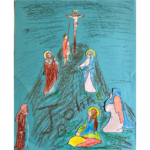
St. Charles Borromeo has always been strongly connected to the Council of Trent that was held in three sessions from 1545 to 1563. This council was a meeting of bishops and priests called by the Popes of the time to clarify the beliefs of the Catholic Faith that were being challenged by the Protestant Reformation, a Movement that challenged the authority and certain beliefs of the Catholic Church.
Charles was only 7 years old at the opening of this Council, having been born in 1538, in the Castle of Arona, Milan, in a family of great influence in the North of Italy. His father was the Count of Arona, and his mother was ‘a Medici’, a very powerful Italian family of those times.
Being the second son in a family of 6 children, he was not destined to inherit the title and wealth of the family. As was the custom in those times, the second son was directed to follow renowned careers within the Church.
His widowed father sent him to Milan for his education, where he was considered as ‘a slow learner’ because of a speech impediment. He strived on, so that when he was 16 years old, he continued with his studies for a Doctorate in Church and Civil Law at the University of Pavia. Charles was 19 years old when after the death of his father, while his brother took over the responsibility of being the Count, he had to take over the responsibility of organizing the family estate and wealth, before returning to his studies.
In 1559, Charles’ uncle, Cardinal John Angelo Medici who had been elected Pope as Pope Pius IV, called Charles to Rome to occupy significant roles there and in the Archdiocese of Milan. He was instrumental in the internal measures to be implemented to reform the Church while encouraging his uncle, the Pope, to bring the Council of Trent to its conclusion in 1563.
Towards the final session of the Council, Charles’ brother died childless and the family Borromeo put pressure on Charles who had not yet been ordained priest, to renounce his career in the Church, get married and provide an heir for the continuation of the family name, Borromeo.
Although he was enjoying wealth and power in his high positions in the Church, at this point in his life he acknowledged that his real vocation was the priesthood. With his studies as background he knew that he could be ordained priest, so he organized his ordination without making it public. From then on, he experienced a transformation in his personal life, as his lifestyle changed from one of wealth and power to one of simplicity. He donated most of his wealth to the poor, spending time in prayer and penance.
By the time he was 25 years old, he was appointed Archbishop of Milan where he was faced with a mammoth task because of the moral and religious situation he had to face. He dedicated his time and energy journeying across his diocese, implementing the decrees of the Council of Trent. During the plague of Milan, while those in authority fled from the city, he stayed on administering to the sick and dying, finding ways and means at his own expense to feed hundreds of people every day.
Charles Borromeo succeeded in igniting a ‘Catholic reawakening.’ He established seminaries to improve training for the priesthood, reviewed liturgical practices especially in the administration of the Sacraments, provided a reformed Catechism, establishing the Confraternity of Christian Doctrine to teach religion to children embracing hundreds of catechists. He also encouraged the Pope to make separation between political and Church appointments.
He was greatly loved by the people of Milan but he was also threatened, to the point of an assassination attempt by opponents, who had been irked by his attempts to ’put things right’.
Worn out by his constant travelling and efforts, Charles Borromeo contracted a strong fever that led him to his death while he was travelling. He was 46 years old.












